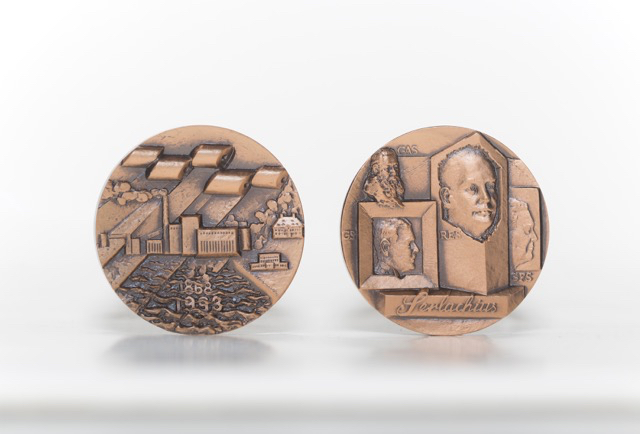Heikki Häiväoja – Serlachius Medal, 1994
Designed by sculptor Heikki Häiväoja, Serlachius medal from the year 1994 celebrates the 125-year the work and history of the Serlachius family as pioneers of the forest industry in Mänttä and as developers of paper industry in Finland. In 1993, the influence that the Serlachiuses had in the industrial life of Mänttä came to an end as Gustaf Serlachius, a Serlachius-director of the fourth generation in line, stepped down from the position of the chairperson of the board of Metsä-Serla Ltd.
The year 2016 marks the 30th anniversary of the merger of the more than hundred-year-old family business G. A. Serlachius Ltd and co-operative-base Metsäliitto Industries Ltd. The new company took the name Metsä-Serla Oy Ltd. The merger of the two companies was published in spring of 1986, but the new company commenced its operations on the last day of that year. It was then the second largest forest combine in Finland after Enso. By the year 1992 Metsä-Serla Oy had become a subsidiary to Metsäliitto and, as such, a part of the Metsäliitto concern.
Medal art is a form of sculpture where a compact story is fitted normally on two small round surfaces. The front side of Heikki Häiväoja’s (b. 1929) Serlachius medal depicts the four mill owner generations of Mänttä. The backside has the silhouette of the mill, paper rolls and Koskelanlampi Pond whose waves reflect the years 1868–1993. Koskelanlampi Pond is a part of Lake Keurusselkä in the Kokemäenjoki water body that drains its waters down the Mäntänkoski Rapid.
According to Gustaf Serlachius’ wishes, the medal highlights his fathers’, Ralph Erik Serlachius’ (RES, 1901–1980) importance for the Finnish paper industry as well as for Mänttä. For 26 years R. Erik Serlachius had been the CEO and for 38 years the chair of the board of the company that his grandfather had established. During his time the company had expanded, and the production of tissue paper had begun in Mänttä.
Former pharmacist, Gustaf Adolf Serlachius (GAS, 1830–1901), father of R. Erik Serlachius’ mother, had established Mänttä ground wood mill in 1868. On the medal, beneath the mill founder can be seen his nephew, Gösta Serlachius (GS, 1876–1942), who was the intendant of Mänttä mill 1903–1908 and CEO of the company from the year 1913 until his death in 1942. Gösta Serlachius’ first wife was his cousin Sigrid (Sissi), daughter of G. A. Serlachius.
The far right edge of the medal’s front side shows the profile of Gustaf Serlachius (GFS, 1935–2009) who conducted the merger with Metsäliitto and lead the family business from 1969 until 1986.
The backside of the medal depicts also the head office of G. A. Serlachius Company, nowadays Museum Gustaf as well as Joenniemi Manor, at present Art Museum Gösta. Originally the manor had been constructed as the main building of the farm and as a home, where Gösta Serlachius and his second spouse Ruth Serlachius (nee. Björkenheim, former Ahlström) entertained their guests. After Mrs Serlachius had died, the first floor rooms used to serve as guest accommodation of the G. A. Serlachius Company, from the year 1963 until the first years of 1980s.
Metsä-Serla Oy had altogether 300 pieces of Serlachius medal made in bronze and some also in silver. Medals have been given to company’s stakeholders and their representatives. It has been awarded to those who have merited themselves in working for the company or for Mänttä. There is one medal in silver and several in bronze in Gösta Serlachius Fine Arts Foundation’s collection.
Marjo-Riitta Simpanen
Curator


